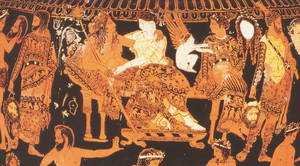
No togas required!
‘We’re not in sandals and togas’ protested Hattie Morahan, who played Iphigenia in Katie Mitchell’s 2004 production of Euripides’ Iphigenia at Aulis at the National Theatre (Theatregoer, July 2004). The usual assumption is that the actors of Greek tragedy were romping around the stage in sandals and togas...and many modern productions reverently bring out the draped bedsheets! But in fact the original costumes were not so minimalist in colour, design or symbolism.
Tragedies were performed at lavish festivals designed to show off Athenian wealth to the rest of the Greek world, and so costumes were for the most part elaborate and expensive rather than bits of old bed linen. There were practical reasons too for not using draped fabrics. The plays were performed by an all-male cast, making adequately secure costumes essential (if not, an unfortunate slip of drapery while playing a female character could really kill the tragic effect...). The roles themselves were physically demanding: characters lie down on stage and get back up, they kneel down and grab at knees, they shake people off, wave torches around, and draw swords – try doing all that draped in a bedsheet!
What did it look like?
If not loosely draped cloth, then what did the costumes look like? The costumes themselves have not survived but there are vase paintings from the fifth century BC which give an idea of costume design. The Pronomos vase (at the top of the page) is an excellent piece of evidence showing actors at an after-show party still in costume and holding the masks they would have worn in performance (actors stand far left and right). The vase is from around 400 BC and so shows costumes at the end of the century in which the great tragic playwrights Aeschylus, Sophocles and Euripides lived.
The costumes have long fitted sleeves and reach down to the knee or the ankle. They are also elaborately patterned. These motifs would be woven in (rather than embroidered or appliquéd), using a loom. Earlier in the century patterned fabric seems more readily associated with ‘barbarian’ (the ancient Greek term for ‘non-Greek’) stage characters. By the end of century, however, Greek characters could wear costumes of patterned fabric and the ‘barbarian’ characters would be marked out by a type of pointed headdress (see female mask on vase).
The actors on this vase wear flat-soled boots. Tragic costume could include different styles of footwear depending on the character being represented. Later on in antiquity, the platform-heeled boots worn by tragic actors became a symbol for tragedy but both the heeled boot and the exaggerated masks were things of the future in the fifth century (when, as the vase shows, masks were still naturalistic).
The evidence of vases needs to be taken with a pinch of salt since they represent artistic responses to performances rather than snapshots of them. The images are also mostly in terracotta and black and so, rather like working from a sepia photograph, we are left to guess the colours. Luckily the texts of the plays themselves give quite a few clues to the colours used for costumes and their meanings. Often the symbolism is easy to decode because it overlaps with familiar ideas in modern society – so, for example, dark clothing is worn in a period of mourning. Other colours, however, are quite different: the most feminine colour for clothing (equivalent to our pink) was a type of yellow! Other codes, like young women being dressed in wedding clothes for their funeral, are unfamiliar to us but the texts make it clear how they could be exploited to dramatic effect. Costume was a visual spectacle for the audience but it also created meaning in the tragedies.
Was costume the secret to tragedy’s success?
Most importantly without the right type of costume, tragedy may not have caught on! Tragic costume evoked the idea of a ‘mythological past’ which enabled the audience to feel distance from the horrors unfolding on stage (making it possible to watch them). ‘Mythological’ (rather like ‘vintage’) in effect meant anything old style and different from the contemporary dress of Athenians. The togas then in modern productions are not so far off, since they too can create the necessary kind of distance. Even so, the dramatic effect and symbolism of the original costumes far outstrips the toga: these costumes, as intricate and significant as the language of tragedy itself, were vital to tragedy’s success.
Want to read more?
Llewellyn-Jones, L. (2001) ‘The use of Set and Costume design in Modern Productions of Ancient Greek Drama’, www2.open.ac.uk/ClassicalStudies/GreekPlays/essays/LLJ1.doc
Taplin, O. (2007) Pots and Plays. Los Angeles.
Taplin, O. and R. Wyles (eds, 2010) The Pronomos Vase and its Context. Oxford.
Wyles, R. (2011) Costume in Greek Tragedy. London.


